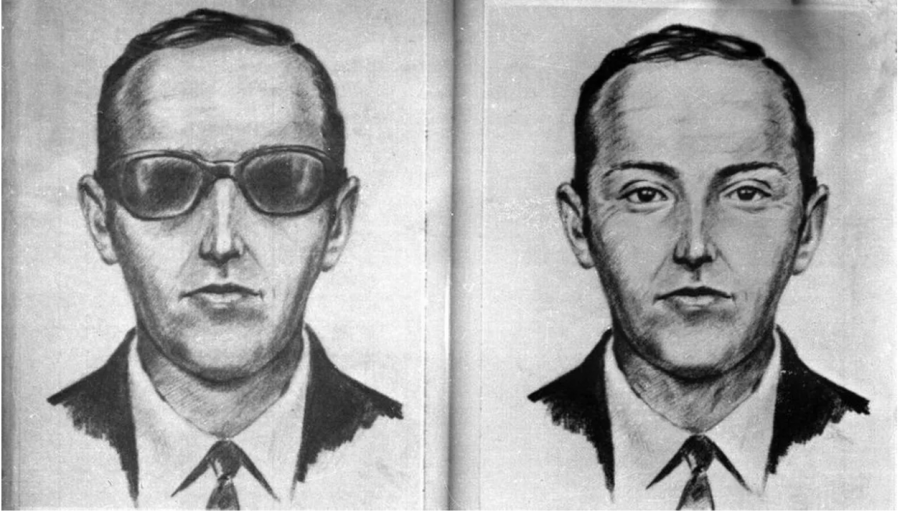Flying into the Cooper Vortex
Briefing:
On Nov. 24, 1971, the day before Thanksgiving, a man identifying himself as Dan Cooper bought an airplane ticket from Portland to Seattle. He hijacked the aircraft, claiming he had a bomb in his briefcase and demanded $200,000 and four parachutes. He jumped out of the plane with the money and the bomb somewhere over the pacific northwest, never to be seen again. The FBI claims to have investigated over 1,000 people including dozens who made deathbed confessions. In 2016, 45 years after the hijacking, the FBI suspended its investigation of the case. While the FBI is no longer looking for Dan Cooper, also known as D.B. Cooper, there is a community of internet sleuths, forensic scientists and armchair detectives who are trying to solve the case on their own. Welcome to the Cooper Vortex. My only question for you is how deep down the rabbit hole do you want to go?
The Sky-jacking:
The average Fordham student may not know the name D.B. Cooper, but their parents might. It’s not even a real name. During the hijacking, an unidentified member of the media overheard an FBI officer talking in a hushed voice about the ongoing incident, and so the alias Dan Cooper became D.B. Cooper — or so the story goes.
Cooper successfully hijacked a Boeing 727 commercial aircraft in U.S. airspace and fled capture without harming a single person, and that’s what makes it so easy to root for him.
On that fated day, the middle-aged man approached the flight counter of Northwest Orient Airlines at Portland International Airport carrying only a black attaché bag. Eyewitnesses described Cooper as being in his mid-40s, wearing a dark business suit with a black tie and white shirt. He purchased a one-way ticket to Seattle-Tacoma International Airport, a mere thirty-minute flight. He paid in cash and was assigned either seat 18C or 15D (both aisle seats).
Flight 305 took off at 2:50 p.m. PST with Cooper on board.Once in the air, he slipped a note to one of the flight attendants, Florence Schaffner, who was seated closest to him and the rear emergency exit. Schaffner assumed Cooper was hitting on her, so without even looking at it, she dropped the note in her purse.
Several minutes later, Schaffner reported that she noticed Cooper staring at her intently. He then waved her down and said, “Miss, you’d better look at that note. I have a bomb.”
The exact wording of the note is unknown; Cooper took it with him when he later jumped. However, Schaffner recalled that it mentioned the bomb and asked her to sit next to him. She complied and quietly asked to see the bomb. Cooper opened his briefcase only long enough for Schaffner to catch a glimpse of eight red cylinders in two rows of four; she assumed they were dynamite. A wire was attached to the cylinders, complete with a large cylindrical battery, all concealed in the briefcase.
After closing and securing the bomb, Cooper made his demands: $200,000 in “negotiable American currency,” four parachutes and a fuel truck standing by in Seattle to refuel the aircraft. Schaffner relayed the message to the cockpit and when she returned, Cooper was wearing dark sunglasses. Cooper also included as part of his demands that meals be brought onto the plane for the flight crew who would see him through the second part of his journey.
Schaffner and fellow flight attendant Tina Mucklow both interacted with Cooper extensively that day. They took turns sitting with Cooper in the rear of the plane and seeing to the various needs of the other passengers. Schaffner reported that Cooper was calm, polite and well-spoken. This is corroborated by Mucklow’s later statements. “He wasn’t nervous,” she said. “He seemed rather nice. He was never cruel or nasty. He was thoughtful and calm all the time.”
As he observed Schaffner getting nervous, Cooper reportedly reassured her, paid his drink tab and tried to use his change to tip her. Mucklow asked Cooper if he had a grudge with Northwest Orient, to which Cooper replied, “I don’t have a grudge against your airline, Miss. I just have a grudge.”
Northwest Orient President Donald Nyrop authorized the payment of the ransom and ordered his staff in the air and on the ground to comply with all of the hijacker’s demands. As the pilot, William A. Scott, communicated with Seattle–Tacoma air traffic controllers and the FBI, the 35 passengers on board were informed that due to “minor mechanical difficulties” their landing would be delayed. This was a fabricated excuse to give the FBI more time to catalog the serial numbers of the cash. The aircraft circled Puget Sound for approximately two hours while arrangements were made.
After landing, all hostages, except four crew members, deplaned and the refueling process started. There was insufficient fuel on the two trucks that the FBI sent and a third had to be arranged. Cooper began getting antsy, stating, “This shouldn’t take so long.” Cooper was informed that a Federal Aviation Administration (FAA) official requested to board the aircraft for a face-to-face meeting, which he refused. Cooper, now impatient, sent a message to the crew urging them to “get this show on the road.”
The Boeing 727 was to fly under specific conditions set by Cooper himself to give him the best chance of survival after the jump. He further specified that the landing gear was to remain deployed in the takeoff/landing position, the wing flaps be lowered 15 degrees, the cabin remain unpressurized and that the aircraft would take off with the rear exit door open and its airstair extended. Northwest’s home office objected to this final specification on the grounds that it was unsafe to take off with the airstairs deployed. Cooper disagreed, insisting that it could be done, but eventually gave in and decided to lower it when they were airborne.
At approximately 7:40 p.m., the plane took off with only five people on board including Cooper. He ordered all remaining staff to stay in the cockpit for the duration of the flight. Approximately 20 minutes later, a warning light flashed in the cockpit, indicating that the stairs had been engaged and deployed. The pilots asked if Cooper needed assistance over the cabin intercom. Cooper picked up the cabin phone and replied, “No.” This would be the last confirmed communication between Cooper and any other living soul.
The plane’s exact flight path and the precise location where Cooper jumped from the plane is disputed, despite the fact that two F-106 fighter aircrafts followed the hijacked plane, one above and one below. However, the weather conditions prohibited them from detecting the jump. Due to a drastic change in air pressure from the stairs snapping closed momentarily before being pulled back down, the Boeing 727 crew assumes that Cooper jumped at 8:13 p.m. PST.
So what happens next? No one knows. But countless people on and offline have been trying to solve this case for 50 years. The mystery of Cooper remains the only unsolved U.S. skyjacking case in history.
The discovery of some of the ransom money along the banks of the Columbia River raised more questions than it answered. Over the 45 years that the FBI conducted an active investigation, it periodically released some of its working hypotheses and tentative conclusions but none of them held up or led to any arrests or developments.
I encourage you to look up some of the deathbed confessions and suspects. They include a family annihilator, a con-man, several paratroopers who fought in World War II and my personal favorite, a transgender woman.

Copy Chief emerita volume 101, Production Editor emerita volume 102 and 103
Vanessa DeJesus is a senior at Fordham College at Rose Hill, double majoring...










































































































































































































